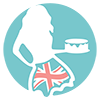0:00
Would you ever guess that this cake was made with these cake layers? It's so frustrating when cake
0:06
layers crack or crumble but here's an easy hack to make them usable. First, why do cake layers break
0:13
Straight out of the oven cakes are very delicate because they firm up as they cool so if you turn
0:18
the pans over straight away the cakes can fall apart or crack or crumble as they fall out of
0:23
the pans. If you wait until the cakes cool and then turn the pans over the cakes can stick to
0:29
the pans and you'll find chunks of cake stuck to the bottom of your pans and big holes in your cakes
0:35
Before showing you how to fix these layers, how can you prevent this happening in the first place
0:40
There are three ways. First, check your pans before you use them to make sure they aren't scratched
0:46
or dented. Scratches in the non-stick surface of the pans will open up areas where the cake can
0:52
stick and dents mean that a pan is no longer perfectly round so the cake can't slide straight
0:58
out of the pan. Number two, always grease your pans before pouring batter into them using butter or
1:05
oil or non-stick spray or to be extra safe you can line them with parchment paper, tracing around the
1:11
pans onto the paper and then cutting those circles out and putting them in the bottom of the pan for
1:16
the easiest, neatest turning out of cakes. Finally, after the cakes come out of the oven, wait about
1:23
10 minutes before you turn them out. Keep poking the pans to check the temperature and as soon as
1:28
you can lift the pans up with your bare hands without burning yourself, the cakes are cool
1:32
enough to turn over. Okay now the part you've been waiting for. What can you do to fix broken
1:39
cake layers so that you can use them for your cake? After taking cakes out of the oven, let the layers
1:44
cool completely and then wrap them up tightly in cling film or saran wrap and put them in the
1:49
freezer for two hours or overnight. The pieces will freeze together which makes them much easier
1:54
to handle. Assemble your cake with buttercream as the filling because buttercream acts as glue when
2:00
it sets. Be generous with the filling because it will sink into any cracks or gaps and fill those
2:05
in to make the cake level and stable. Alternate your cake layers and filling and since the layers
2:11
were frozen, they'll chill and set the buttercream filling within a few minutes and that buttercream
2:16
once it's set, will hold everything together like glue. Flatten the sides of the filling if it's
2:22
bulged out by spreading it against the sides of the cake and that will fill in any gaps there to
2:26
make nice straight sides. A crumb coat is essential if your cake layers are broken because this first
2:33
layer of frosting, called a crumb coat, will catch all of those crumbs that come off the cake. Then
2:39
chill the cake for 30 minutes in the fridge or 15 minutes in the freezer and spread on your final
2:44
layer of frosting and since the crumb coat has been chilled, this final coat will sit on top of
2:49
it and none of the crumbs from the crumb coat will get through into this layer of frosting
2:54
Through into this layer of frosting so you'll have beautiful crumb-free frosting and a straight
2:59
level cake and even when you cut into it, no one will ever know how ugly the cake layers were
3:04
originally. Subscribe to my channel for more cake hacks, recipes, tips and frosting and decorating
3:10
techniques and visit my online cake school for courses and live workshops. Thanks for watching


